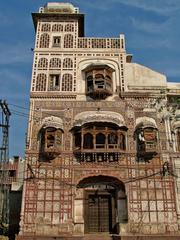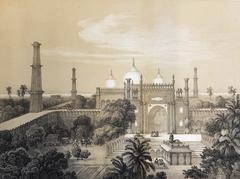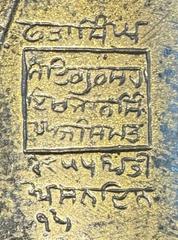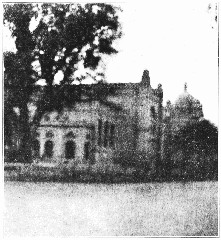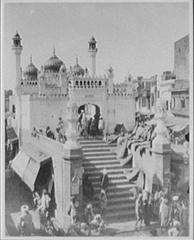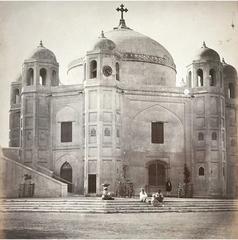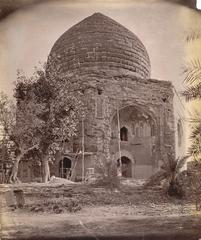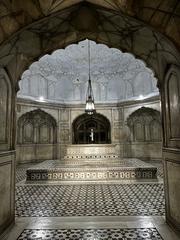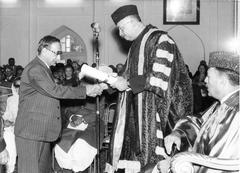Visiting the Tomb of Allama Iqbal, Lahore: Guide, Tickets, Hours, and Travel Tips
Date: 03/07/2025
Introduction: History and Significance
The Tomb of Allama Iqbal is a majestic and deeply symbolic monument situated in the heart of Lahore, Pakistan. Dedicated to Muhammad Iqbal (1877–1938), revered as the “Spiritual Father of Pakistan,” the mausoleum honors his pivotal role in inspiring the movement that led to Pakistan’s creation. Iqbal’s poetry and philosophy provided intellectual foundations for the country, promoting unity, self-realization, and a vision for a separate Muslim homeland. Completed in 1951 and located within Iqbal Park—adjacent to the iconic Badshahi Mosque and Lahore Fort—the tomb is a harmonious blend of Islamic, Mughal, Afghan, and Moorish architectural styles. The tranquil Persian-style gardens and calligraphic engravings of Iqbal’s verses enhance the monument’s contemplative atmosphere, making it a focal point for cultural events, national commemorations, and educational tours. This guide provides essential information on visiting hours, accessibility, nearby attractions, and travel tips for an enriching experience at one of Lahore’s most treasured historical sites (Secret Attractions, Trek Zone, Punjab Tourism).
Historical Background and Symbolism
Allama Iqbal: The Visionary Behind Pakistan
Muhammad Iqbal was a philosopher, poet, and political thinker whose writings in Persian and Urdu inspired the Muslim community of South Asia. His vision, articulated in his famous Allahabad Address (1930), laid the intellectual groundwork for Pakistan’s creation. After his death in 1938, Iqbal was interred in Lahore—his adopted city and the epicenter of his political activities. The mausoleum was constructed to honor his enduring influence on the region (Secret Attractions).
Construction and Architectural Context
Construction began in 1946 and concluded in 1951. Nawab Zain Yar Jang Bahadur, an architect from Hyderabad Deccan, designed the monument, skillfully integrating traditional and modern styles. Its location in Iqbal Park, adjacent to the Badshahi Mosque and Lahore Fort, underscores Iqbal’s central role in both Lahore’s and Pakistan’s cultural narrative.
Architectural Features
- Materials and Structure: The mausoleum combines red sandstone from Jaipur and white marble from Makrana, reminiscent of Mughal grandeur.
- Dome and Arches: A prominent central dome symbolizes spiritual aspiration; arches and jali (latticework) echo Mughal and Islamic aesthetics.
- Calligraphy: Verses from Iqbal’s poetry are inscribed in elegant scripts, celebrating his literary legacy.
- Gardens: Inspired by the Persian charbagh, the surrounding gardens symbolize paradise and tranquility.
National and Cultural Significance
The tomb is a national monument and site of pilgrimage, especially on Pakistan Day (March 23) and Iqbal Day (November 9). It is a venue for poetry recitations, educational tours, and official ceremonies, reinforcing Iqbal’s impact on Pakistani identity and thought (Secret Attractions).
Location, Layout, and Accessibility
Location
Situated within Hazuri Bagh—a Mughal-era garden—the tomb sits between the Badshahi Mosque and Lahore Fort, making it easily accessible and integral to Lahore’s historical landscape (Trek Zone).
Accessibility
- By Road: Located near Circular Road, accessible by car, taxi, or rickshaw. Parking is available nearby.
- Public Transport: Multiple bus routes and ride-hailing services (Careem, Uber) serve the area.
- Pedestrian Access: Well-marked paths connect the tomb to adjacent landmarks.
- Wheelchair Access: The site features ramps and paved walkways for visitors with mobility challenges.
Visiting Hours, Tickets, and Security
- Opening Hours: Daily from 8:00 AM to 7:00 PM (may vary on public holidays or special events).
- Entry Fee: Free for all visitors, both Pakistani nationals and foreigners.
- Security: Regular security checks are in place; police and Rangers maintain a safe and orderly environment, especially during ceremonies (Punjab Tourism, Evendo).
Site Features and Visitor Amenities
Architectural Details
- Exterior: Octagonal structure of red sandstone, complemented by white marble domes and minarets.
- Interior: Houses Iqbal’s grave beneath a white marble slab and features intricate calligraphy and mosaics.
- Gardens: Charbagh-style layout with floral beds, trees, fountains, and seating areas.
Facilities
- Restrooms: Available near the entrance.
- Drinking Water: Provided onsite.
- Seating and Shade: Benches and shaded areas throughout the gardens.
- Information Desk: Educational materials and assistance available.
- Accessibility: Ramps and paved walkways throughout.
Food and Shops
- Onsite: No food stalls within the complex.
- Nearby: Numerous eateries and tea stalls near Badshahi Mosque and Lahore Fort (TripAdvisor).
Guided Tours and Interpretation
- Guided Tours: Local guides offer informative tours for a nominal fee, providing historical and architectural context.
- Self-Guided: Informational plaques in Urdu and English are placed around the site.
- Combined Tours: Many guided city tours include the tomb, Badshahi Mosque, and Lahore Fort for a comprehensive heritage experience (UNESCO).
Dress Code and Cultural Etiquette
- Dress Modestly: Men should avoid shorts; women are advised to cover arms and legs. Headscarves are not mandatory but appreciated.
- Respectful Behavior: Maintain silence in the mausoleum, avoid loud conversations, and refrain from disruptive activities.
- Photography: Allowed in gardens and exteriors; flash photography inside the mausoleum is discouraged or prohibited.
Best Times to Visit
- Season: October to March offers the most pleasant weather (15°C–25°C).
- Time of Day: Early mornings and late afternoons provide gentle lighting and fewer crowds.
- Events: National holidays and Iqbal Day feature special ceremonies but may be crowded (Pakistan Meteorological Department).
Nearby Attractions and Suggested Itineraries
- Badshahi Mosque: An architectural masterpiece and one of the world’s largest mosques.
- Lahore Fort: UNESCO World Heritage Site with palaces and museums.
- Hazuri Bagh: Historic garden ideal for strolls.
- Lahore Museum: Houses artifacts related to Iqbal and the Pakistan Movement (Lahore Museum).
- Food Street: Offers traditional Punjabi cuisine and vibrant atmosphere.
A suggested itinerary: Morning visit to the tomb, then Badshahi Mosque and Lahore Fort, lunch at Food Street, and an afternoon at Lahore Museum.
Safety and Security
- Security Presence: Police and Rangers ensure safety.
- Checkpoints: Security checks at the entrance are standard.
- Personal Safety: Petty crime is rare; maintain general precautions.
Tips for a Respectful and Memorable Visit
- Check for scheduled events or closures in advance.
- Dress appropriately; bring a scarf or shawl if needed.
- Respect photography restrictions inside the mausoleum.
- Combine the visit with nearby sites for a richer experience.
- Stay hydrated, especially in warmer months.
- Consider hiring a guide for deeper insights.
Frequently Asked Questions (FAQ)
Q: What are the tomb’s opening hours?
A: 8:00 AM to 7:00 PM daily, with possible variations during public holidays.
Q: Is there an entry fee?
A: No, entry is free for all visitors.
Q: Are guided tours available?
A: Yes, local guides can be hired at the entrance.
Q: Is the site wheelchair accessible?
A: Yes, paved walkways and ramps are available.
Q: Can I take photographs inside the mausoleum?
A: Allowed in gardens and exteriors; flash photography inside the mausoleum is discouraged.
Q: What is the best time to visit?
A: October–March, early morning or late afternoon for optimal weather and lighting.
Visual and Media Recommendations
- Use high-quality images of the tomb’s architecture, gardens, and inscriptions.
- Recommended alt tags: “Tomb of Allama Iqbal Lahore,” “Red sandstone mausoleum Lahore,” “Iqbal mausoleum gardens.”
- Interactive maps and virtual tours are available on cultural heritage websites.
Conclusion and Final Tips
The Tomb of Allama Iqbal embodies the intellectual spirit and cultural heritage that define Pakistan’s national identity. Its striking blend of architectural styles, serene gardens, and rich symbolism make it a must-visit landmark for anyone interested in history, poetry, or culture. With free entry, accessible facilities, and proximity to Lahore’s major historical sites, it offers a rewarding experience for all visitors. Plan ahead, observe cultural etiquette, and consider exploring the surrounding sites for a full day of discovery in Lahore.
For more travel tips, updates, and Lahore historical site guides, download the Audiala app and follow us on social media.
